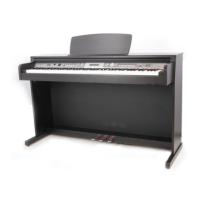n Chord basics
A chord consists of three or more notes played together. The most common
chord is the triad consisting of three notes: root, third and fifth of the corre‐
sponding scale. The C-major chord, for example, is formed from the notes C
(root), E (the third note of the C major scale) and G (the fifth note of the C major
scale). In the shown chord C major, the lowest note is the root note (this is the
basic form of the chord - if you play other notes of the chord as the lowest note,
this is called 'chord inversion'). The root note is the central tone of the chord on
which the other chord notes are based. The distance (interval) between adjacent
notes and the root note determines whether the result will be a third major or
minor.
n Chordal structure
The lower interval in our triad (between the root and third) determines whether
the result will be a major or minor triad. In addition, we can get the highest note
by a half step up or down to create two additional chords.
The basic characteristic of the triad is obtained, even if we change the order of
notes to create different inversions. Successive chords can be linked together in a
soft chord progression, e.g. by selecting appropriate chord inversions (also called
'voicings').
Functions
digital piano
26

